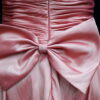Staff writer Meghana Praveen comments on the re-emergence of Tumblr’s toxic aestheticization of eating disorders.
Matty Healy is white boy of the month, the “Teen Wolf” movie is coming, fishnets are back in…we’re back in 2014. But do we want to be? Just when you think social media is finally learning the concept of body neutrality and Tumblr users are getting over the deep-seated insecurities created by the platform, 2014 Tumblr rears its head again.
If you’re unfamiliar with this era, the social media platform Tumblr became synonymous with a grungy dark aesthetic and edited photos of cigarettes that had angsty text pasted over them. Popular clothing items included ripped black skinny jeans, fishnets, worn-out band T-shirts, and Dr. Martens 1460s. While the poster child for this aesthetic was Effy Stonem from the TV show “Skins”, it could also be seen in other icons like Jenny Humphrey from “Gossip Girl”, the Olsen twins, and Sky Ferreira. Style forecasters have predicted that indie sleaze is coming back, and the main problem with the return of this style is that it was exclusively designed for skinny bodies. This desire to go back in time stems from Gen Z, who are too young to have fully lived through the Tumblr era and have fallen in love with the aesthetic. The cyclical nature of trends has made this comeback inevitable, but the rapidity with which the 2014 Tumblr aesthetic has come back speaks to how social media is making the concept of the 20-year cycle obsolete.
This era is infamous for its romanticisation of mental illness and eating disorders. A central quote to the ED culture of the time came from Kate Moss, “nothing tastes as good as skinny feels”. Music by artists like Lana del Rey treated sadness and depression as something that wasn’t debilitating, which in some ways spread a message of positivity, but also made people think that it was necessary to emulate her melancholy. Melancholia, as a concept, has not disappeared from pop culture in recent years. Instead, the aestheticization of melancholia has shifted from Tumblr, which overtly celebrated it, to more subliminal forms. Women who are thin and sad are still considered more interesting and are the protagonists we tend to gravitate towards. Popular literature in recent years, including books such as “My Year of Rest and Relaxation”, “Bunny”, and “Normal People”, has tended to discuss topics regarding mental illness, but often features protagonists with the same, skinny body types.
There were definitely positive aspects of this era, as it allowed teenagers to connect with others who were in the same situation as them. It was easier than connecting in person due to the lack of mobility and the stigma connected with mental illness. But, within this bubble, young people who were not suffering felt it necessary to create these struggles in order to make themselves “fit in”, leading to self-diagnosis. Additionally, weight was considered a factor that adolescents could “control” in troubling times.
The main perpetrator of this return is TikTok. Scrolling through the app, one might notice that WIEIAD’s (What I Eat In A Day) are trending, for all the wrong reasons. Young teens are posting their meals, or lack thereof, with posts going as far as to call seasoned ice “snack inspo”. One trending filter on TikTok morphed the user’s face, giving them sunken cheekbones and dark circles. This filter was extremely popular, but has been widely criticised for promoting a look associated with anorexia. Further proof of the return of this skinny aesthetic, there has been a significant change in Kim Kardashian’s body, the speculated removal of her BBL.
Two prominent TikTok sounds can be seen as further evidence of this return. The first one is from “American Psycho”, using the quote “you can always be thinner, look better”, and the second one, consistent with the recent idolisation of Bella Hadid, “so name, my name is Bella Hadid“. The latter sound has been used by TikTok users to talk about how they refuse dessert or an extra helping of dinner. Both sounds have been used satirically by most, but the awareness of the harmful effects of an ED does not stop the perpetuation of the aesthetic in this case.
The obsession with how women’s bodies look can be traced back to the early 19th century. Poets and writers have been romanticising female sadness and depression for centuries, often making it a requirement for a woman to be beautiful. For example, Edgar Allan Poe in “The Philosophy of Composition” perpetuates this idea through the line: “the death, then, of a beautiful woman is, unquestionably, the most poetical topic in the world”. Another example of this is in the conversation between the characters Henry and Dorian in Oscar Wilde’s “The Portrait of Dorian Gray”, in which Henry convinces Dorian that he is lucky a woman killed herself for him, adding that he wishes a beautiful woman would have done that for him. This ever-persistent interest in a woman’s sadness is partly because of the lack of mobility and control of women in these harmful spaces for the mind, which makes them easier to manipulate.
Bodies should not be subject to the trend cycle. Nostalgia for the sense of community and a new creative outlet might be clouding Tumblr users’ memory of the platform, but this time around, maybe we should consider including everyone in this aesthetic and not traumatise a whole new generation.


















